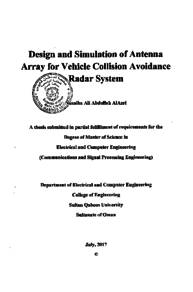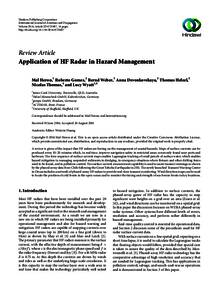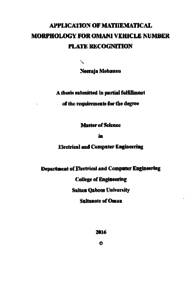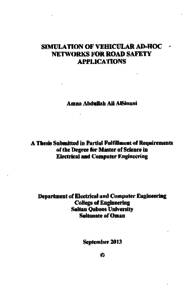وثيقة
Design and simulation of antenna array for vehicle collision avoidance radar system
الناشر
Sultan Qaboos University
ميلادي
2017
اللغة
الأنجليزية
الموضوع
الملخص الإنجليزي
Collision avoidance system is a driver assistance system with high capabilities to detect and alert the driver about any potential risk in the road. Realizing such system requires detection sensors to expose the blind spots for the driver at any time of the day under any weather condition and at an affordable cost. Automotive radar sensors exhibit an ideal and superior performance under all environmental conditions; hence, it meets the application requirements, In automotive radar system, antenna subsystem has an essential role since it is the means by which the signal is transmitted and received. Therefore, this project concerns the design of antenna arrays for the automotive radar applications. The design of an automotive radar antenna system is challenging. Some of these challenges include achieving a high gain (26-35 dB), narrow beamwidth (49-109) and low sidelobe level (equal or less than 20 dB). In addition to these, meeting the equipment physical constraints like size and integration on an automobile at a low cost is also considered a challenge. A high gain and a narrow beamwidth can be achieved by using antenna arrays that consists of a number of antenna elements. To meet the cost, size, weight, performance and ease of installation constraints, microstrip antennas are usually used. Therefore, a rectangular microstrip antenna with inset feed was designed, modelled and optimized to operate at the frequency of 76.5 GHz. This frequency was selected according to the ITU standardization for global harmonization of frequency allocation at 76-81 GHz for automotive radar application. However, the use of antenna arrays introduces mutual coupling between the different elements that degrades the performance, which is also studied for designed arrays to ensure that it is les than -15 dB. At the ITU designated frequency band, the wavelength is in the order of 4 mm resulting in small antennas that lower the overall cost as well as improvement in the range, velocity and angular resolution for better target identification. The microstrip antenna was analyzed using a transmission line model. The modeling and simulation of the antenna was carried out using time domain solver package to examine the antenna performance in terms of radiation pattern, bandwidth, efficiency, gain, return loss and mutual coupling between elements. The optimal rectangular microstrip antenna array was a 64 element planar antenna array of overall size of (24.64 x24.21*0.467) mm". The simulation results showed that the 64-element planar antenna array has a gain of 18.7 dB, half power beamwidth of 10.2°, a sidelobe level of -17.4 dB, a return loss of -23.3. Although not all parameters achieve the requirements, however they constitute an improvement on the results reported in the literature.
الوصف
Thesis
المجموعة
URL المصدر
الملخص العربي
نظام تفادي الاصطدام عبارة عن نظام مساعد للسائق يتميز بقدرات عالية لتحذير السائق من أية مخاطر محتملة في الطريق. ويشمل النظام على حساسات تكشف النقاط العمياء للسائق خلال أي وقت من اليوم وتحت أية ظروف جوية، ويأتي ذلك كله بتكلفة معقولة. و حيث أن أجهزة الرادار تقدم أداء مثاليا و متفوقا في ظل جميع الظروف البيئية لذا فإنها تلبي متطلبات التطبيق في نظام رادار المركبة تقوم الهوائيات بدور أساسي كونها تمثل وسيلة استقبال و إرسال الإشارات. عليه فإن هذا المشروع يهتم بتصميم مصفوفات هوائية خاصة بتطبيقات رادار المركبة. و يعد تصميم الهواني لنظام الرادار تحديا حيث تشمل هذه التحديات تحقيق كسب عالي ( 35-26 ديسبيل ) و عرض شعاع ضيق (10-4 درجات ) و مستوى الفص الجانبي المنخفض ( يساوي أو أقل من20 ديسبيل ) . إضافة إلى هذه التحديات فأن التوصل إلى حجم مناسب للهوائي يسهل ويلائم دمجه كجزء من المركبة بتكلفة منخفضة يعتبر أيضا تحديا . يمكن الحصول على كسب عالي و عرض شعاع ضيق عن طريق الهوانيات المصفوفة التي تتألف من عدد من الهوائيات. في المعتاد يتم استخدام الهوائيات الشريطية الدقيقة ( ميكروستريب ) لاستيفاء شروط التكلفة و الحجم و الوزن و الأداء و سهولة التركيب. لذلك في هذا المشروع تم تصميم هوائي شريطي (ميكروسترب) مستطيل مع تغذية مدرجة للعمل على تردد .576 جيجا هرتز . وقد تم اختيار هذا الترد وفقا لمعايير الاتحاد الدولي للاتصالات الخاصة بالترددات على المستوى العالمي بحيث يكون النطاق 76-81 جيجا هيرتز مخصص لتطبيقات رادارات المركبات. لكن استخدام الهوائيات المصفوفة يخلق اقتران متبادل بين العناصر المختلفة المكونة للمصفوفة الذي بدوره يضعف الأداء. لذا تم تتبع ودراسة أداء المصفوفات المصممة وذلك لضمان أن النسبة أقل من 15 ديسيبل. ووفقا لنطاق التردد المخصص من قبل الاتحاد الدولي للاتصالات فإن طول الموجة يبلغ حوالي 4 ملم الأمر الذي نتج عنه هوائيات صغيرة الحجم تعمل على تقليل التكلفة الإجمالية وفي نفس الوقت تحسين مستوى المدى والسرعة والوضوح الزاوي وبالتالي تحسين مستوى تمييز الأهداف. وقد تم تحليل الهوائيات الشريطية (هوائيات الميكروسترب) باستخدام نموذج خط النقل. أما عملية تشكيل ومحاكاة الهوائيات فقد تم القيام بها عبر استخدام برنامج للمحاكاة في نطاق الزمن وذلك للتحقق من أداء الهوائي من حيث نمط الإشعاع وعرض النطاق والكفاءة والكسب والفقد المرتد والإقتران المتبادل بين العناصر. وتعتبر المصفوفات الهوائية التي تتكون من 64 عنصرا وبحجم كلي يبلغ ( 24 . 64 × 24 . 21 x 0 . 467) ملم: هي المصفوفة المثالية الهوائيات الشريطية المستطيلة. وقد أظهرت نتائج المحاكاة أن مصفوفة الهوائيات المسطحة المكونة من 64 عنصرا قد حققت معدل کسب بلغ 18 . 7 ديسيبل ومعدل نصف طاقة شعاع العرض بلغ 10 .2 ° ومستوى الفصوص الجانبية وصل إلى - 17 . 4 ديسيبل بينما بلغ معدل الفقد المرتد -3. 23. وعلى الرغم من عدم مساهمة كافة العناصر في تحقيق المتطلبات، إلا أنها ساهمت في تحسين النتائج التي تم التطرق اليها.
قالب العنصر
الرسائل والأطروحات الجامعية




